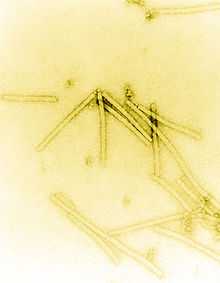Pepper mild mottle virus
| Pepper mild mottle virus (PMMoV) | |
|---|---|
| Virus classification | |
| Group: | Group IV ((+)ssRNA) |
| Order: | Unassigned |
| Family: | Virgaviridae |
| Genus: | Tobamovirus |
| Species: | Pepper mild mottle vrus |
Pepper mild mottle virus (PMMoV) is a plant pathogenic virus that occurs worldwide on species of field grown bell, hot and ornamental pepper species. It is caused by members of the plant virus genus Tobamovirus- otherwise known as the Tobacco mosaic virus family. Tobamovirus are viruses that contain positive sense RNA genomes that infect plants.[1] Symptoms of the disease vary depending on the cultivar. Typical symptoms include the chlorosis of leaves, stunting, and distorted and lumpy fruiting structures. The virus is spread by mechanical transmission and infected seeds. Avoidance is the best means of controlling the disease because once a plant is infected it cannot be treated. Only seeds that have been tested and treated for the pathogen should be planted.[2]
History
The origin of PMMoV has been linked to the Tomato mosaic virus, as they both reside in the Tobacco mosaic virus family. The Tunisian Journal of Plant Protection brought about the link between PMMoV to ToMV from a French study dating back to 1964. ToMV affects a wide range of Solanaceous crops and a strain of this virus likely mutated into PMMoV.[3]
Host and Symptoms


The Pepper Mild Mottle Virus is the major viral pathogen of peppers (Capsicum spp.).[4] The host range of PMMoV include most cultivars and species of pepper (Capsicum spp.). This virus strain does not infect tomato, eggplant, or tobacco; however, other members of the genus Tobamovirus can infect these other hosts[5] PMMoV is one of at least 4 different species of Tobamovirus that infect peppers.[6] The others include Tobacco mosaic virus (TMV), Tomato mosaic virus (ToMV) and Tobacco mild green mosaic virus (TMGMV).

This pathogen is known to occur throughout the world and it frequently results in significant crop losses or reductions in both field and greenhouse plantings. The virus has been identified in places like Australia, Japan, China, Taiwan, Europe, and North Africa. Since 1997, PMMoV has been the cause of many major outbreaks in the southeastern states namely Georgia and Florida.[4]
Symptoms caused by this pathogen vary based on the specific host cultivar; however, a majority of the symptoms are very similar between the different hosts. Symptoms usually include various degrees of mottling, chlorosis, curling, dwarfing, and distortion of the fruit, leaves, and even whole plants. The symptoms on fruit include: a reduction in size, mottling and color changes, and an obvious distorted and lumpy appearance. Also, many times brown necrotic streaks or splotches can be seen on the leaves and fruit. The symptoms can easily be seen on new growth, and they are far more pronounced if the plant was infected when it was young rather than when it was older.
This disease is harmful because of the mild foliar symptoms (chlorosis, necrosis, etc.) and due to this many times the pathogen goes unnoticed until the more evident symptoms on the fruit appear. This is why there are higher yield losses because symptoms only become evident during the fruiting stage right before the crops are supposed to harvested.[7]
Disease Transmission
PMMoV is a rigid rod shaped virus pathogen that can be easily transmitted to healthy plants via mechanical inoculation or contact between plants or another medium that can carry the pathogen such as hands, gloves, and clothing. The virus is commonly found on the outer seed coat and very rarely in the endosperm of seeds of the infected plants. Being seedborne, the virus primarily infects through mechanical contamination during seed transplanting and other agricultural procedures. It enters the plant/seed through microscopic abrasions or wounds. The virus is in vitro, which in this case means it can survive in an isolated environment, and being highly infectious it can easily be transmitted during normal crop maintenance. PMMoV is exceptionally stable and it is known to survive for extended periods of time in plant debris and on greenhouse structures, pots, and horticultural tools. There are no known insect vectors; however, humans can be considered the main vector for this pathogen.[8]
Environment
This virus is widespread and is found almost anywhere peppers are grown, this is because the virus is most often introduced with the pepper seed. The virus moves long distances on the seed and moves short distances via plant-to-plant contact, handling of plants by contaminated implements and workers aids in the spread of the virus.[9] Soils with low organic matter content, specifically humus will much more readily promote the adsorption of PMMoV. Specifically, the allophanic clays and iron minerals in these soils will promote the adsorption of PMMoV.[10]
Disease incidence has occurred mainly in greenhouse environments and hot, humid environments like southwest and southeast Florida and in regions like North Africa, and Japan. This is an indication of the type of soil that is optimal for the virus; warm or hot and humid. Greenhouses, specifically, are an ideal production environment for rapid spread of the disease.[11]
Prevention, control and management

Up until 2005, the primary means of prevention was a pre-plant treatment of Bromomethane or methyl bromide. The import and production of this fumigation chemical was banned under the Montreal Protocol. A modern organic method of prevention was found by a Japanese study on soil adsorptions role in the adsorption of PMMoV. The study found that increased humus content in a soil will have an inhibitory effect on PMMoV adsorption.[10]
As with all plant viruses, but especially with those in the Tobamovirus genus, avoidance is the best means of control. Growers must practice good sanitation procedures and only plant clean seeds. Growers must also use caution when handling plants, plants with abrasions or wounds give the virus an opportunity to enter the tissue of the plant.There are no chemical or biological control methods that can be used to control the disease once the plant is infected. Though often a challenge, accurate identification of PMMoV is key to successful control of the disease. (See reference 7 for a detailed description of control measures for this virus.)
Diseased plant material will remain infectious until completely broken down. Tillage, increased irrigation, and high temperatures encourage the breakdown of plant material in the soil. Any infected plant material in the soil can serve as a source of inoculum for subsequent crops so crop rotation should be practiced, if possible. Volunteer peppers and weeds, particularly those in the Solanaceae family (such as nightshades), should be removed to reduce possible sources of infections. Due to the fact that smoke can spread the disease, burial or composting of the diseased plants should be implemented rather than burning. The composted diseased plant remains should not be used on a pepper crop or other Solanaceous crops.[5]
Importance
Controlling this virus is important for pepper production worldwide, but recent research shows that this plant disease may be transmitted to humans. A French study identified a local source of PMMoV and linked the presence of PMMoV RNA in stool with a specific immune response and clinical symptoms. Although clinical symptoms may be imputable to another co-factor, including spicy food, the data in the study suggested the possibility of a direct or indirect pathogenic role of plant viruses in humans.[12]
In an article from the Applied and Environmental Microbiology Journal, it was found that PMMoV could be a potential indicator of fecal pollution. Their results demonstrate that PMMoV is widespread and abundant in wastewater from the United States, suggesting the utility of this virus as an indicator of human fecal pollution. Quantitative PCR was used to determine the abundance of PMMoV in raw sewage, treated wastewater, seawater exposed to wastewater, and fecal samples and/or intestinal homogenates from a wide variety of animals. PMMoV was present in all wastewater samples at concentrations greater than 1 million copies per milliliter of raw sewage.[13]
Though there have been no major outbreaks in humans, the transmittance of this plant virus to humans has created a discussion on the viability of humans as vectors for plant viruses.
References
- ↑ Hu Q, Hollunder J, Niehl A, Kørner CJ, Gereige D, Windels D, Arnold A, Kuiper M, Vazquez F, Pooggin M, Heinlein M (2011). "Specific impact of tobamovirus infection on the Arabidopsis small RNA profile". PLoS One 6 (5): e19549. doi:10.1371/journal.pone.0019549. PMID 21572953.
- ↑ Plant Pathology Fact Sheet: Pepper mild mottle virus http://ufdc.ufl.edu/IR00001690/00001
- ↑ Mnari-Hattab, M.; Ezzaier, K. (2006). "Biological, Serological, and Molecular Characterization of Pepper mild mottle virus (PMMoV) in Tunisia" (PDF). Tunisian Journal of Plant Protection 1 (1): 1–12.
- ↑ 4.0 4.1 Jarret, R.L.; Gillaspie, A.G.; Barkley, N.A.; Pinnow, D.L. (2008). "The Occurrence and Control of Pepper Mild Mottle Virus (PMMoV) in the USDA/ARS Capsicum Germplasm Collection". Seed Technology Journal 30 (1): 26–36.
- ↑ 5.0 5.1 http://edis.ifas.ufl.edu/cv275
- ↑ Wetter, C. (1984). "Serological Identification of Four Tobamoviruses Infected Pepper" (PDF). Plant Disease 68 (7): 597–599. doi:10.1094/pd-69-597.
- ↑ "Peppers, Tomatoes, and Tobamoviruses" Plant Pathology Circular No. 400 (2000) http://www.freshfromflorida.com/content/download/11406/144732/pp400.pdf
- ↑ Nagvi, S.A.M.H. (ed.). Diseases of Fruits and Vegetables: Diagnosis and Management. Springer. ISBN 9781402018268.
- ↑ "Pepper Mild Mottle Virus." American Vegetable Grower, 59.9 (2011): 30.
- ↑ 10.0 10.1 Yoshimoto, Ryota, Hirotaka Sasaki, Tadashi Takahashi, Hitoshi Kanno, and Masami Nanzyo. "Contribution of Soil Components to Adsorption of Pepper Mild Mottle Virus by Japanese Soils." Soil Biology & Biochemistry, 46 (2012): 96-102.
- ↑ http://ufdc.ufl.edu/IR00001690/0000
- ↑ Colson P, Richet H, Desnues C, Balique F, Moal V, et al. (2010) Pepper Mild Mottle Virus, a Plant Virus Associated with Specific Immune Responses, Fever, Abdominal Pains, and Pruritus in Humans. PLoS ONE 5(4): e10041. doi:10.1371/journal.pone.0010041
- ↑ Rosario, K.; Symonds, E.M.; Sinigalliano, C.; Stewart, J.; Breitbart, M. (2009). "Pepper Mild Mottle Virus as an Indicator of Fecal Pollution" (PDF). Applied and Environmental Microbiology 75 (22): 7261. doi:10.1128/AEM.00410-09.